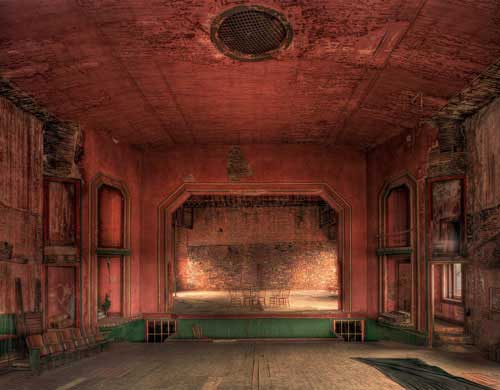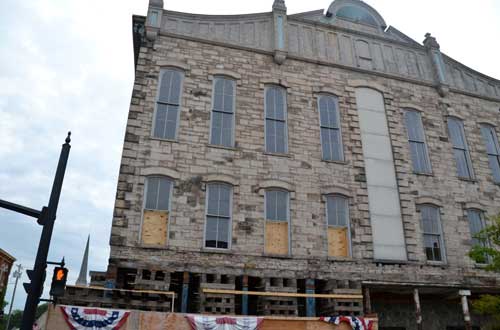List of 7 endangered sites in NY includes historic opera houses
2 opera houses in Orleans have both been spared the wrecking ball

Walter Jakubowski took this photo about five years ago of the interior of the Pratt Opera House on the third floor of a building in downtown Albion.
ALBANY – The Preservation League of New York State has announced its annual list of “Seven to Save” and this year’s group includes historic opera houses around the state.
Orleans County is home to opera houses and both sites have been spared the wrecking ball. But other communities aren’t so fortunate.
In Albion, Michael Bonafede and his wife Judith Koehler worked to save the Pratt Opera House at 118 North Main St. They have put on a new roof and made a series of other interior and exterior improvements to the building, which has several tenants on the first and second floors.
In Medina, the Orleans Renaissance Group acquired the Bent’s Opera House in 2008 from the Bank of America for free. The ORG has since sold the site to Talis Equity, with is led by CEO and founder Roger Hungerford.
Bent’s Opera House, which was built in 1864, will be brought back to its original luster with the third floor restored faithfully into one of the most unique wedding and event venues in New York State, Hungerford has said. The first and second floors will experience a dramatic redesign into a restaurant and modern boutique hotel space.
The Preservation League included historic opera houses to the Seven to Save and said this about the buildings:
“Opera houses are a ubiquitous building type across upstate New York, found in rural towns and villages, regional commercial centers and major cities,” according to the Preservation League. “The opera house was not only a venue for cultural activities, but also the heart of the community and a place to relax, socialize, and be entertained and enlightened. The buildings are characterized by lower floor public space with an upstairs auditorium and often anchor main streets.

File photo: Talis Equity, which is led by Roger Hungerford, is working on a restoration project at the former Bent’s Opera House in Medina. This photo from 2014 shows work to stabilize the front corner of the building when it was owned by the Orleans Renaissance Group.
“But times changed, and upstate opera houses went dark. While many were lost to demolition or insensitive alterations, the survivors require creative solutions to meet building code requirements and once again welcome the public. The Preservation League will work to promote best practices for reopening these charming performance spaces by publicizing successful efforts, and provide technical assistance for advocates who wish to follow suit.”
The Preservation League of NYS’s 2018-19 “Seven to Save” Endangered Properties List draws attention to the loss of historic fabric in National Register-listed Historic Districts; development pressures; and reuse challenges. These seven valued historic resources are in danger of disappearing because of vacancy, disinvestment, and lack of public awareness.
“Since 1999, Seven to Save has mobilized community leaders and decision-makers to take action when historic resources are threatened,” said Jay DiLorenzo, president of the Preservation League. “A Seven to Save designation from the League delivers invaluable technical assistance, fosters increased media coverage and public awareness, and opens the door to grant assistance for endangered properties.”
Other “Seven to Save” designees include:
• South End-Groesbeckville National Register Historic District – Albany, Albany County
In the mid-nineteenth century, this neighborhood was densely populated with German and Irish immigrants who worked in Albany’s nearby port and socialized and worshiped within walking distance of their homes. By the mid-twentieth century, many of these families had left the neighborhood, leaving behind widespread abandonment and soaring vacancy rates. In 2015, New York State adopted the International Fire Code which identifies vacant structures with potentially hazardous conditions with a large red “X” placard. This neighborhood exemplifies the challenges that municipalities face in addressing issues of vacancy and deterioration in historic districts while protecting the safety of first responders. The League will work with stakeholders to discuss strategies for stimulating investment in the South End.
• Watervliet Shaker National Register Historic District – Colonie, Albany County
Just north of Albany is the location of the first Shaker settlement in the United States, founded by Ann Lee in the late 18th century. The Shakers were highly regarded for their architecture, inventions, and domestic arts. The district includes three clusters or “families” of buildings: the Church Family, the South Family, and the West Family in a mix of classic Shaker-style architecture. Bordered by the Albany International Airport and two major highways, the site is threatened by encroaching development which could lead to loss of context or outright demolition. The League will work with advocates and local municipalities to highlight the significance of this site.
• Haglund Building/Jamestown Arcade – Jamestown, Chautauqua County
Jamestown, the largest city in Chautauqua County, boasts a National Register-listed downtown commercial historic district and many historic neighborhoods. The Richardsonian Romanesque Jamestown Arcade once housed retail, theaters, clubs, and studios and retains many intact interior features, including molding, metalwork, tin ceilings, decorative woodwork, and fixtures. Over the years, a series of owners made plans to stabilize and save the Arcade Building, but none have succeeded. The Preservation League will work with city officials, preservationists, developers, local advocates and the arts community to create a plan for stabilization and rehabilitation which takes advantage of Federal and NYS Historic Tax Credits.
• Wells Barns – Various Municipalities, Monroe/Livingston Counties
John Talcott Wells, Sr. developed an ingenious truss system that addressed the shortcomings of typical post-and-beam barn construction by strengthening interior framing while simultaneously creating open space in the upper sections of the structure. In 1889 he received a patent for his “Wells Truss System for Buildings or Bridges.” Only found in a small section of Western New York, Wells Barns are difficult to identify from the exterior, but they usually feature gambrel roofs and a double window with a decorative lintel underneath the gable, and are sometimes called “Country Cathedrals.” The League will work with the Wells Barn Legacy Project to preserve the heritage of this unique barn type in the face of a shifting agricultural landscape.
• Enlarged Erie Canal Schoharie Aqueduct – Fort Hunter, Montgomery County
A National Historic Landmark and part of the New York State Barge Canal Historic District, the Schoharie Aqueduct carried the Erie Canal over the Schoharie Creek. Construction of the aqueduct began in 1839 and it was placed into service in 1845, with additional alterations in 1855 and 1873. As the canal was rerouted, the Schoharie Aqueduct was no longer needed and fell into disrepair. Despite a stabilization and restoration plan completed by New York State, large portions of the aqueduct have collapsed and the remainder has not been stabilized. The League will work with Friends of Schoharie Crossing State Historic Site to advocate for its preservation and maintenance as New York launches the adjacent Empire State Trail.
• Lehigh Valley Railroad Roundhouse and Related Structures – Manchester, Ontario County
This railroad roundhouse once served the Lehigh Valley Railroad, which primarily hauled coal from Pennsylvania west through the Southern Tier and Finger Lakes to Buffalo, and east through New Jersey to New York City. At the Manchester Roundhouse, workers fixed trains, refueled, exchanged freight and switched cars. In its heyday, it was one of the largest freight transfer centers in New York State. Now vacant for more than 30 years, the site’s brownfield status presents additional challenges to plans for rehabilitation. The League will help the town of Manchester and Ontario County follow environmental protocols, historic preservation and sensitive rehabilitation measures as they boost awareness of transportation history in Western New York.
Additional information about each of the designees is are available on the Leagues’ website at www.preservenys.org.







































































